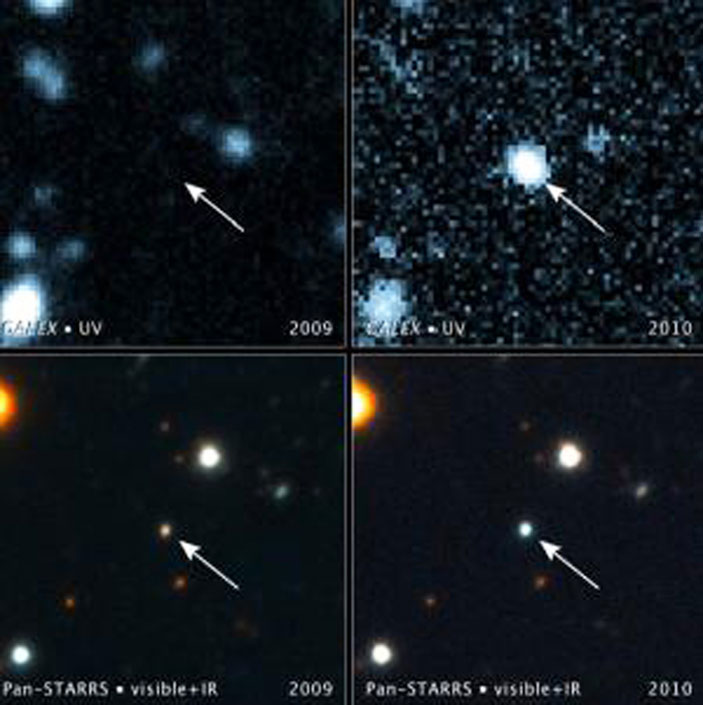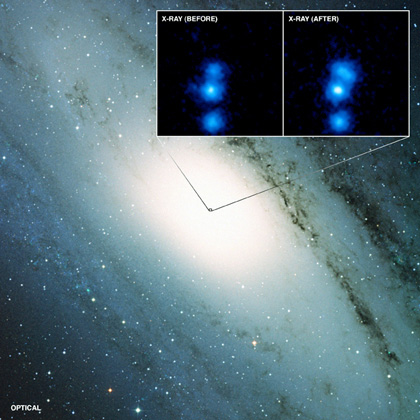Gravity enables life. In a very sparse
cosmos, gravity gathers enough matter to form stars and planets. It
squeezes stars until they burst with the energy that supports life and
the atoms from which planets and people are made.
But gravity also destroys its own creations.
Astronomers often witness stars and
planets being eaten by bigger stars and by black holes. It’s cannibalism
on a cosmic scale, and not for the faint of heart.
A star like our Sun will burn steadily
for billions of years, providing a serene environment for its orbiting
planets. But, when such stars exhaust their thermonuclear fuels, they
shed their outer layers and their cores collapse to form White Dwarfs,
objects about the size of Earth but with masses comparable to our Sun.
That’s the fate of the least-massive 95% of all stars, including our
Sun. A single teaspoon of White Dwarf would “weigh” 30 tons. Gravity on
its surface could be up to one million times greater than on Earth, and
its surface temperature could be up to 250,000 °F, 25 times our Sun’s
current temperature.
Planets orbiting too close to these stars may be consumed.
Astronomers reported this month observing four White Dwarfs
that have planet guts running down their chins—spectral lines of iron,
nickel and sulfur, elements typically found not in stellar atmospheres
but in the cores of terrestrial planets like Earth. One of these stars
is now consuming an estimated one thousand tons of planet guts every second.
While iron and nickel may be tasty, they
are rare delicacies in our universe. Truly mammoth appetites require
more readily available fare. How about helium? The images below show a
galaxy 2.7 billion light-years away (one light-year is six trillion
miles). The two images on the left were taken in 2009, just before
dinner, and the two images on the right are from 2010. The upper image
pair was taken in ultra-violet (UV) light and the lower pair in visible
light. The images show that the central black hole of this galaxy
consumed the helium core of a star. The image is brightest in UV because
the helium gas became very hot as it fell into the black hole at 20
million mph. Astronomers think we may be seeing the dessert course; the
star may have passed near the black hole many years ago when its
hydrogen gas was eaten during the entree course. Helium is heavier than
hydrogen, thus it sinks to the star’s center and is more tightly held.
The outer hydrogen layer is much easier for the black hole to strip off
and gulp down. The mass of this black hole is estimated to be three
million times our Sun’s mass.

Galaxy PS1-10jh: 2009 left, 2010 right, UV upper, optical lower
Below we see a visible light image of
Andromeda, our large neighboring galaxy also called M31. Inset are two
x-ray images of its core. In January 2006, x-ray emission from M31’s
central black hole increased one hundred-fold as it munched on some
delicacy, perhaps a giant gas cloud, a star, or just the odd planet.

M31, Andromeda Galaxy
Finally, we have M83, a galaxy 15
million light-years away. It apparently has a mid-sized black hole of 40
to 100 solar masses in its spiral arms. X-ray emissions from that
location jumped 3000-fold in 2011, when it is thought to have consumed a
companion star.

M83
Yummy. What are you having for dinner?
Best Regards,
Robert
May 16th, 2012
Note: Previous newsletters can be found on my website.
|